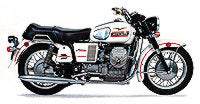Moto Guzzi History
1917

Carlo Guzzi and Giorgio Parodi meet in the Italian Air Force and agree to start a motorcycle company after the war.
A third pilot in their unit, Giovanni Ravelli, was a well-known racer of the time. He would have become a Moto Guzzi partner as well, but he was killed in a plane crash.
1920

Built with the help of the town blacksmith in the moutain village of Mandello, Carlo Guzzi's original prototype features a four-valve overhead-cam 500 cc single-cylinder engine mounted horizontally.
1921

With the G.T. (Grand Tourer), Moto Guzzi introduced the sprung frame. The world was not yet ready, however and only 78 were ever built.
1924

After the championship of Europe at the Monza Autodrome, the Secretary of the International Federation wrote: "The three Guzzis . . dominated the event virtually from beginning to end, thus proving the importance of the Italian mortorcycle industry."
1928

With the G.T. (Grand Tourer), Moto Guzzi introduced the sprung frame. The world was not yet ready, however and only 78 were ever built.
1930

A horizontal 4-cylinder competition bike is introduced. In this era, all of the men at the Moto Guzzi factory sign their hand-built engines personally.
1933

Moto Guzzi introduces its first V-Twin, the 500 cc "Bicilidrica".
1935

Irishman Stanley Woods rides a "quarter-liter" -class Guzzi victory in the Tourist Trophy race on the Isle of Man. It was the first win by a non-British machine in 24 years.
1940

Moto Guzzi production is interrupted by World War II.
1947

A Guzzi takes the Isle of Man Tourist Trophy once more--the factory team's first post-war win.
1955

The otto cilindri, or 8-cylinder Guzzi debuts at the Belgian Grand Prix. The only motorcycle of its kind ever built, the V8 proved to be a formidable racing machine.
1957

Moto Guzzi wins its fifth consecutive world champonship in the 350 cc class. Later that same year, the company officially retires from Grand Prix racing after 3,000 victories and 8 world championships.
1960

Under contract to the Italian military, Moto Guzzi produces the truck-like 3 X 3, powered by a totally new engine: the 90-degree transverse V-twin.
1965

700-cc V7 makes its debut at the Milan show. With it is introduced the 90-degree V-twin engine that will become the Guzzi signature.
1967

Lino Tonti succeeds Giulio Cesare Carcano as chief engineer.
1971

The V7 sport, 850 GT, and the first California are introduced at the Milan Show. These models were still almost completely hand made.
1973

Alessandro De Tomaso buys Moto Guzzi. He also owns Benelli, and later adds Maserati and Innocenti.
1984

Guzzi introduces its first 1000 cc LeMans.
1989

Guzzi Quota 1000 off-road bike sports a 1000-cc powerplant packing 72 horsepower.
1992

The Daytona is launched--a 100 hp bike with Guzzi's most modern styling to date.
1994

The California 1100-Guzzi's Heavyweight Custom/Cruiser appears, available with carburetors or fuel -injection.
1996

A re-invigorated Moto Guzzi celebrates its 75th anniversary with a production output of 6,500 bikes. Now the longest--standing motorcycle manufacturer in Italy, Moto Guzzi is committed to increasing production to 20,000 units in the early years of the 21st Century.
1997

The Future of Moto Guzzi-The Centauro -Radically styled "Naked Sport Bike".
1998

The Quota 1100 ES replacing the Quota1000 debuts in the U.S., adding a dual purpose sport bike to the Moto Guzzi family. At home climbing the countryside hills as well as dodging pot holes in the city, the Quota 1100 ES becomes Moto Guzzi's Urban Assault Vehicle.
2000

Debuting at the Milan Cycle Show in 1997, the V11 Sport reaches the U.S. market in 2000. With it's green-red color scheme the V11 Sport is reminiscent of the legendary V7 Sport of the '60s. Acquisition of Moto Guzzi S.p.A. by Aprilia S.p.A. . Aprilia's technology, especially in manufacturing and logistics, quickly accelerates Moto Guzzi's modernization of production. In turn, Moto Guzzi not only strengthens Aprilia, but also adds important engine production capability/capacity to the company's portfolio of strategic options.
2001

Technology and 80 years of tradition merge in the new Limited Edition V11 Sport Rosso Mandello, the Moto Guzzi café racer.
Moto Guzzi Celebrates 80 Years of Motorcycling Excellence.
2004

The MGS 01. This track use only bike was designed with Ghezzi and Brian. The 1,225cc engine featuring 4 valve heads produces 122 hp and 115 Nm. The bike has tasted racing success at Daytona in the Battle of the Twins.
2005

The Breva 1100 is released. This is the first model to feature the CARC (Cardano Reattivo Compatto) drivetrain design. The system separates the shaft final drive’s torque reaction from the suspension via floating torque arms and thereby eliminates the abruptness typical of shaft drive systems on acceleration or throttle-release.
Later in 2005 the Griso 1100 goes on sale, this radically styled naked bike is widely acclaimed.
2006

Guzzi returned to "Gran Turismo" with the Norge 1200. Offering complete protection, a sophisticated chassis and a new 1200cc twin cylinder engine.
2007

The Griso is the first bike to receive the new 8 valve engine. The 1200cc Griso 8V produces 110 bhp.
2008

The Stelvio 1200 4v sees Moto Guzzi return to the adventure bike market for the first time since ceasing production of the Quota.
More Historic Guzzi's

Normale

Corsa C4V

GT Norge

GTS 500

Airone 250

Motoleggera 65

Galletto 192

Falcone Sport

350 Bialbero

8 Cilindri

V7 Record
